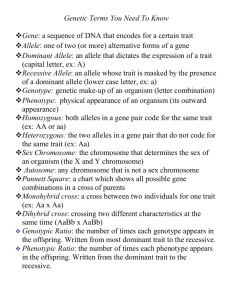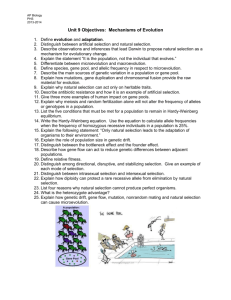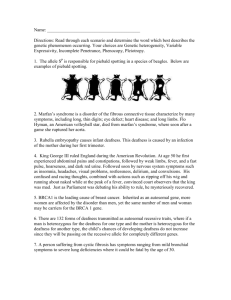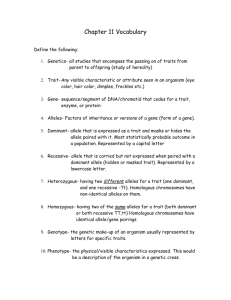Answers to test 1
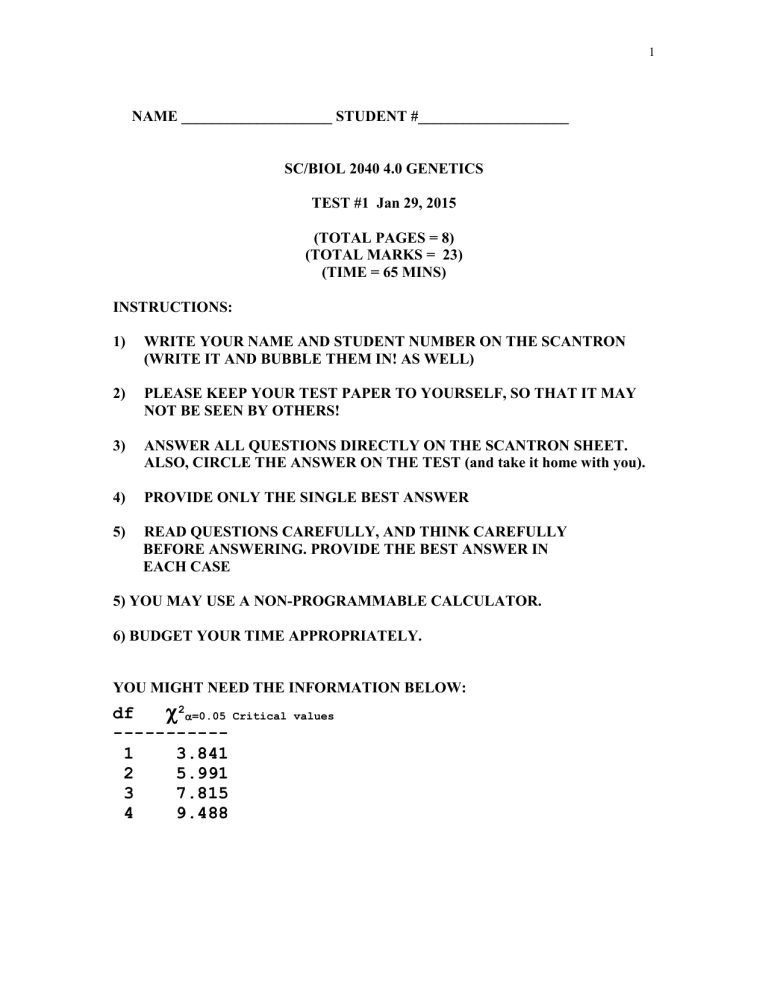
NAME ____________________ STUDENT #____________________
SC/BIOL 2040 4.0 GENETICS
TEST #1 Jan 29, 2015
(TOTAL PAGES = 8)
(TOTAL MARKS = 23)
(TIME = 65 MINS)
INSTRUCTIONS:
1) WRITE YOUR NAME AND STUDENT NUMBER ON THE SCANTRON
(WRITE IT AND BUBBLE THEM IN! AS WELL)
2) PLEASE KEEP YOUR TEST PAPER TO YOURSELF, SO THAT IT MAY
NOT BE SEEN BY OTHERS!
3) ANSWER ALL QUESTIONS DIRECTLY ON THE SCANTRON SHEET.
ALSO, CIRCLE THE ANSWER ON THE TEST (and take it home with you).
4) PROVIDE ONLY THE SINGLE BEST ANSWER
5) READ QUESTIONS CAREFULLY, AND THINK CAREFULLY
BEFORE ANSWERING. PROVIDE THE BEST ANSWER IN
EACH CASE
5) YOU MAY USE A NON-PROGRAMMABLE CALCULATOR.
6) BUDGET YOUR TIME APPROPRIATELY.
YOU MIGHT NEED THE INFORMATION BELOW: df
2
=0.05 Critical values
-----------
1 3.841
2 5.991
3 7.815
4 9.488
1
2
1. A biologist interested in the development of ears, generates a number of ear mutations in mice using the chemical mutagen, EMS. She then attempts to determine whether each mutant shows segregation consistent with single gene ratios by carrying out the appropriate set of crosses. This process above is best described as: a) Northern blotting b) Meiosis c) Reverse genetics (in reverse you begin with anonymous DNA sequence) d) Exon splicing e) Genetic analysis f) Homologous pairing
2. A mutation causes a single base pair substitution resulting in the occurrence of a stop codon only 30 base pairs into the beginning of the sequence of a gene (called Pgm ) that is
2000 base pairs in length. If the Pgm gene is haploinsufficient, an individual heterozygous for the mutation will most likely: a) produce only a non-functional form of the Pgm enzyme b) produce a bivalent form of the protein c) show a mutant phenotype d) show a normal phenotype e) show the phenotype of a chromosome at pachytene f) none of the above
3. In just one of the telophase I nuclei of the yellow mongoose ( Cynictis penicillata ) you find the total number CHROMATIDS to be 36. How many CHROMOSOMES occur in a somatic cell of this species following the S phase of the cell cycle? a) 9 b) 18 c) 27 d) 36 e) 72 f) none of the above
4. For question 3 above, how many double-stranded DNA molecules would you expect to find in the nucleus of one sperm cell? a) 9 b) 18 c) 27 d) 36 e) 72 f) none of the above
5. Which of the following is NOT correct with respect to CAPs: a) they do not involve the use of restriction enzymes b) they show co-dominance c) heterozygotes can be distinguished from both homozygotes d) it is a method for directly detecting DNA variation using gel electrophoresis e) they can show single gene Mendelian ratios
6. A null mutation occurs in a gene that is haplosufficient. If you testcross an individual heterozygous for the null mutation, what is the expected ratio of Normal (non-mutant) to mutant phenotypes? a) 3 Normal : 1 Mutant b) 1 Normal : 1 Mutant c) 1 Normal : 3 Mutant d) all Normal e) all Mutant f) None of the above
7. For a diploid species of grasshopper you find that the DNA content of just one of the telophase II nuclei is 12 picograms (pg). How many picograms of nuclear DNA would you expect to find in a cell at pachytene? a) 48 pg b) 24 pg c) 12 pg d) 6 pg e) 3 pg f) none of the above
8. For question 7 above, how much nuclear DNA would you expect to find in a somatic cell immediately after mitosis (and its associated cytokinesis)? a) 48 pg b) 24 pg c) 12 pg d) 6 pg e) 3 pg f) none of the above
3
4
9. Which of the following best describes introns? a) they are found only at the ends of chromosomes b) they represent heterochromatic regions at the centromere of chromosomes c) they are proteins involved in packaging DNA into chromatin d) they are a new fundamental particle in biology analogous to muons in physics e) they are seen only at pachytene f) none of the above
10. A biologist discovers a colour polymorphism in the mottled rock rattlesnake
( Crotalus lepidus ) where a light coloured and a dark coloured form occur. The biologist generates pure breeding lines of both the light and dark snakes. F
1
progeny are light in colour. If a single gene determines the colour of these snakes, what would be the expected proportion of the colour forms in the F
2
? a) all light b) all dark c) 3/4 light : 1/4 dark d) 1/4 light : 3/4 dark e) 1/2 light : 1/2 dark f) none of the above
11. For the cross above (in question 10) and assuming single gene inheritance, what is the expected proportion of heterozygotes in a testcross of an F
1
snake? a) 1 b) 1/4 c) 1/2 d) 3/4 e) 0 f) None of the above
12. A man and women are both normal but have a first child with Roberts syndrome, caused by an autosomal recessive allele. The couple intends to have 3 more children.
What is the probability that NONE of the next 3 children have Roberts syndrome? a) 3/4 b) 1/4 c) 1/8 d) 8/27 e) 1/64 f) none of the above
5
13. For question 12 above, what is the probably that exactly two of these next 3 children have Roberts syndrome? a) 1/16 b) 3/16 c) 1/9 d) 9/64 e) 1/81 f) None of the above
14. In birds, females are the heterogametic sex having a Z and a W chromosome, while males are homogametic, having two Z chromosomes. In the species, the great speckled bird, a Z linked recessive mutation causes all white feathers while the “normal” allele gives the speckled colour. If you cross a white male with a speckled female which of the following gives the correct proportion of various progeny with respect to gender and colour? a) ½ male speckled : ½ female white b) ½ male white : ½ female speckled c) ½ male speckled : ¼ female white : ¼ female speckled d) ¼ male speckled : ¼ male white : ½ female white e) ½ male speckled : ½ female speckled
15. A biologist uses an RFLP to study the inheritance of an autosomal gene, Adh , in fruitflies. The biologist obtains two pure breeding parental lines of flies. When the RFLPs are detected using the usual Southern blotting, one parental line shows 1 band, while the other line shows two smaller bands. The F
1
progeny show all 3 bands. An F
2
is generated and the RFLPs are screened for 200 of the F
2
progeny. The results are below:
Number of progeny showing
1 Band 2 Bands 3 Bands
Observed numbers 37 53 110
Carry out a goodness of fit test to determine whether these data are consistent with the expected single gene ratios (critical values of the chi-square distribution are on the first page of the test paper). Which one of the following is correct? The results are: a) consistent with expected single gene ratios because chi-square = 4.56 b) not consistent with expected single gene ratios because chi-square = 4.56 c) consistent with expected single gene ratios because chi-square = 20.79 d) not consistent with expected single gene ratios because chi-square = 20.79 e) consistent with expected single gene ratios because chi-square = 295.48 f) not consistent with expected single gene ratios because chi-square = 295.48 g) nothing can be determined from the information provided
6
16. Which of the following is NOT a model organism? a. Fruitfly ( Drosophila melanogaster ) b. Donkey ( Equus africanus ) c. Arabidopsis ( Arabidopsis thaliana ) d. House mouse ( Mus musculus ) e. all are model organisms
17. A gel showing segregation of a single strand conformation polymorphism (SSCP) for two alleles is shown below. DNA was extracted and PCR carried out for 10 progeny
(lanes 1 through 10 on the gel) from an F
2
which was analyzed in order to explore the
SSCP inheritance pattern.
1 2 3 4 5 6 7 8 9 10
For the cross of an individual from Lane 2 with an individual from Lane 5, which of the following is correct? a) All progeny would have three bands b) Three different banding patterns would occur corresponding to lanes 1, 2 and 5 c) All progeny would be homozygous d) Two different banding patterns would occur corresponding to lanes 2 and 5 e) All progeny would have the banding pattern of lane 2. f) none of the above
18. Cystic fibrosis is determined by an autosomal recessive allele in humans. A couple know they are both heterozygous carriers of this recessive allele. What is the probability that their 2 nd
child will have the disease? a) 1/4 b) 1/2 c) 1/3 d) (1/4)
2 e) 9/16 f) 3/4 g) none of the above
19. For question 18 above, imagine the couple are going to have only 3 children. What is the probability that all 3 children are homozygous for the “normal” allele? a) 1/2 a) 1/4 b) 2/3 c) 27/64 e) 1/64 f) 1/8 g) none of the above
20. The inheritance of a single gene trait is shown in the human pedigree below:
Which one of the following is correct with respect to the trait? a) It must be due to an autosomal recessive allele b) It must be due to an autosomal dominant allele c) It must be due to an X-linked recessive allele d) It must be due to an X-linked dominant allele e) None of the above
A
21. For the pedigree in question 20 above, imagine that the trait is determined by an Xlinked recessive allele of a single gene. What is the probability that the individual labeled
"A" is heterozygous? a) 1/4 b) 1/3 c) 1/2 d) 2/3 e) 3/4 f) none of the above
7
8
22. Inheritance of a single gene trait is shown in the chimpanzee pedigree below.
A
What is the correct mode of inheritance of the trait? a) It is caused by an autosomal recessive allele b) It is caused by an autosomal dominant allele c) It is caused by an X-linked recessive allele d) It is caused by an X-linked dominant allele e) Impossible to determine this with certainty
23. For the pedigree above (in question 22), and assuming that the trait is very rare in the population, what is the probability that the first offspring of the mating of individuals labelled A and B, will NOT have the trait? a) 8/9 b) 3/4 c) 5/6 d) 11/12 e) 2/3 f) none of the above
B




